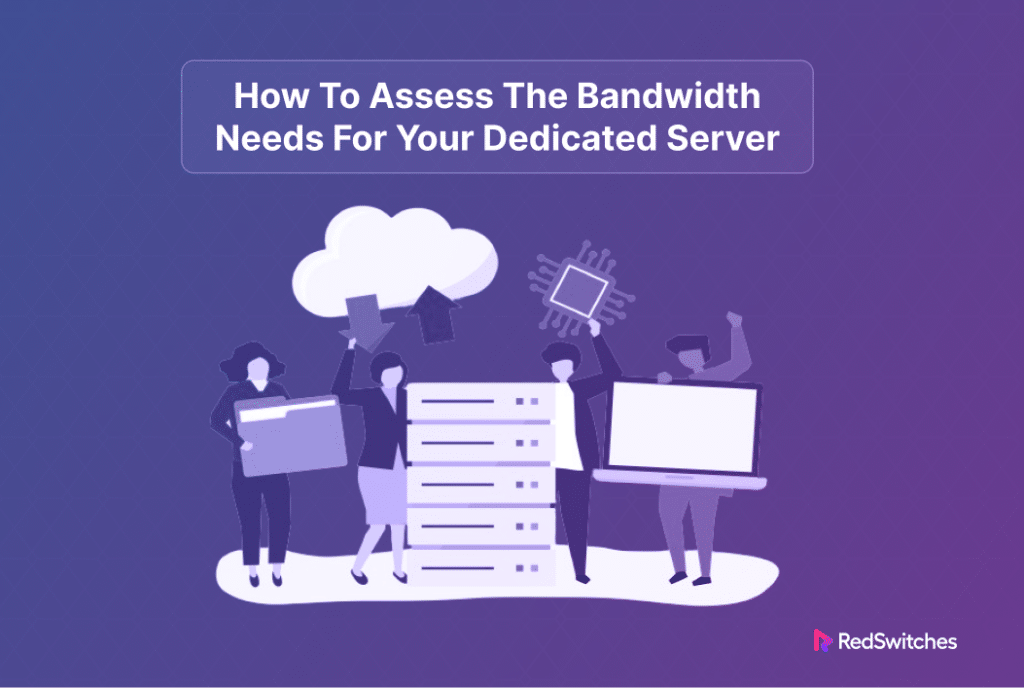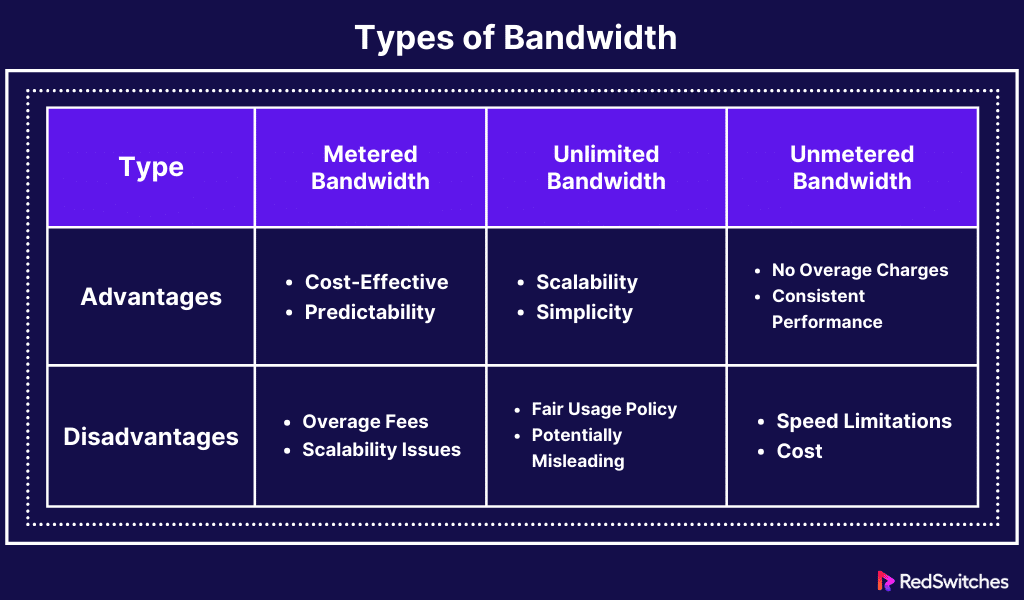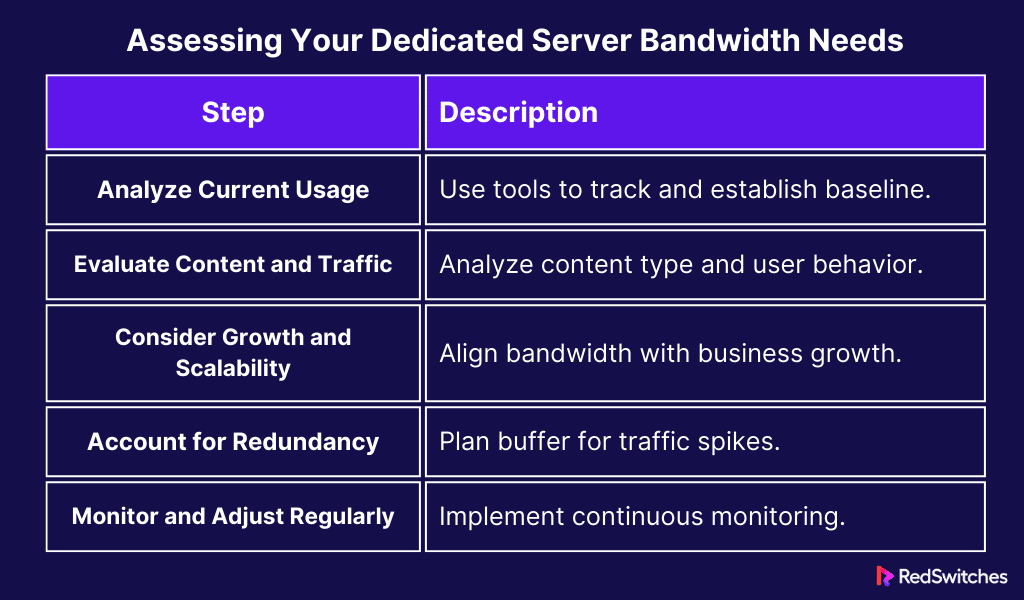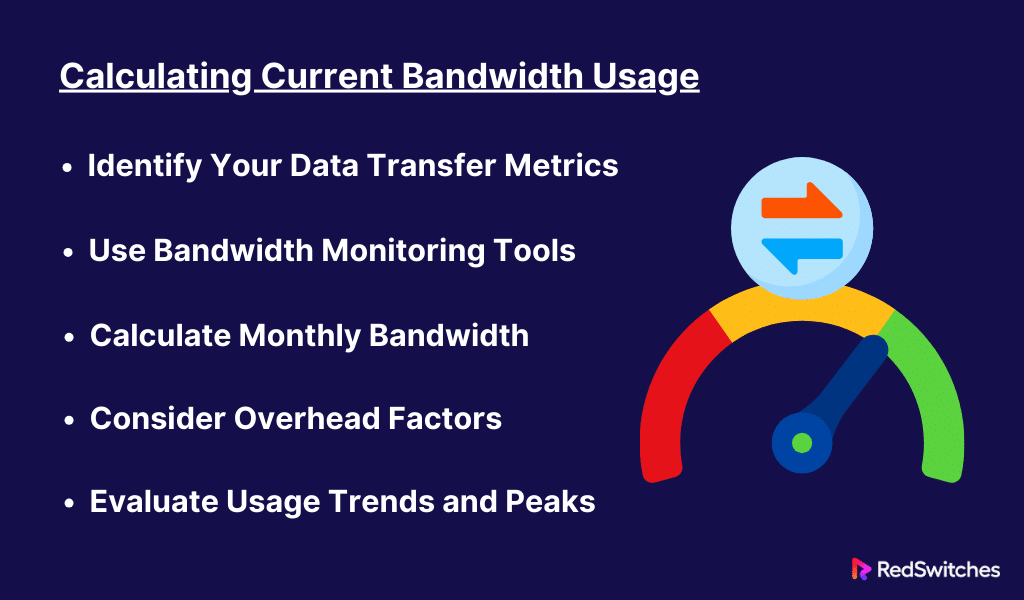Key Takeaways
- Bandwidth is the data transferred over a network connection within a given period.
- There are different types of bandwidth. This includes metered, unlimited, and unmetered.
- Each bandwidth option comes with its own usage limitations and pricing structures.
- Bandwidth is crucial for dedicated hosted servers, affecting their performance and reliability.
- Assessing your server’s bandwidth needs involves understanding factors like traffic volume, peak usage times, and types of content served.
- Calculating current bandwidth usage helps determine whether an upgrade or optimization is necessary.
- Adjusting server configurations, implementing caching mechanisms, and using content delivery networks (CDNs) are strategies for upgrading bandwidth.
Did you know the total amount of data captured, created, consumed, and copied worldwide is predicted to reach 180 zettabytes by 2025? This highlights the need for understanding and assessing your server’s bandwidth needs.
Bandwidth is an essential factor influencing the performance and reliability of your website or application. Whether you’re starting a blog, an e-commerce platform, or an extensive enterprise system, ensuring enough bandwidth is essential. This helps ensure you meet user expectations and also supports business operations.
This blog will guide you through the steps to accurately assess your dedicated server bandwidth requirements and touch upon bandwidth’s important role for your dedicated hosted server.
Table of Contents
- Key Takeaways
- What is Bandwidth?
- Types of Bandwidth
- The Role of Bandwidth in Dedicated Servers
- Assessing Your Dedicated Server Bandwidth Needs
- Factors Influencing Bandwidth Requirements
- Calculating Current Bandwidth Usage
- Strategies for Upgrading and Optimizing Bandwidth
- Why Choose RedSwitches for Your Server Bandwidth Needs?
- Conclusion
- FAQs
What is Bandwidth?
Credits: FreePik
Bandwidth is the volume of data transmitted over an internet connection in a given period. It is usually measured in bits per second (bps). It represents the connection’s capacity to transfer data between the web and devices or between different points on a network.
Higher bandwidth means more data can be transmitted simultaneously, leading to faster data transfer rates and improved performance for activities such as streaming, downloading, and web browsing.
In internet services, bandwidth is commonly used to indicate the maximum pace at which data may be downloaded or transferred from a certain service. For example, if your bandwidth is 100 Mbps (megabits per second), it is the fastest pace at which data may be moved to and from your internet-connected devices.
Sufficient bandwidth is crucial in a networking or server environment to handle data traffic efficiently. It ensures that websites and online services can load quickly and operate smoothly, even with high user traffic or data-intensive applications.
Do you want in-depth information on unmetered bandwidth? Read our blog, ‘All About Unmetered Bandwidth Server.’
Types of Bandwidth
Before we assess the bandwidth needs for your dedicated hosted server, it is important to discuss the various types of bandwidth available.
Metered Bandwidth
Metered bandwidth means that your server has a specified monthly data transfer allowance. For example, if a dedicated hosted server comes with 5 TB of metered bandwidth, you can transfer up to 5 terabytes of data over the Internet within the billing cycle.
Advantages
- Cost-Effective: Often less expensive initially, as you pay for a set amount of data transfer.
- Predictability: Easy to predict monthly costs if your website traffic is consistent.
Disadvantages
- Overage Fees: You can incur additional charges if you exceed the allocated bandwidth.
- Scalability Issues: During traffic spikes, you might max out your bandwidth and negatively impact website performance.
Ideal for: Small to medium-sized businesses with predictable traffic patterns and limited budget constraints.
Unlimited Bandwidth
Unlimited bandwidth hosting plans claim to offer unlimited data transfer for your server. While this sounds ideal, it’s important to note that truly unlimited bandwidth is not feasible due to physical and infrastructural limitations.
Advantages
- Scalability: Good for websites with fluctuating traffic, as it can handle sudden spikes without additional charges.
- Simplicity: Easier budgeting with a flat fee structure and no need to monitor data transfer closely.
Disadvantages
- Fair Usage Policy: Providers often have a fair usage policy, meaning your server’s data transfer rates might be throttled if usage is excessive.
- Potentially Misleading: The term “unlimited” can be misleading, as there are always limitations based on server capacity and network resources.
Ideal for: Websites with variable traffic where the owner wants to avoid overage fees and is fine with potential fair usage limitations.
Unmetered Bandwidth
Unmetered bandwidth does not have a fixed limit on the amount of data you can transfer. Instead, it limits you by the connection’s speed (bandwidth capacity). For example, a server with a 100 Mbps unmetered connection will not have a data transfer cap, but the data can only be transferred at a maximum speed of 100 Mbps.
Advantages
- No Overage Charges: You won’t face additional fees for high data transfer volumes.
- Consistent Performance: Suitable for high-traffic websites, providing consistent performance without worrying about hitting a data cap.
Disadvantages
- Speed Limitations: The transfer speed is capped, which might affect data delivery during peak times.
- Cost: Unmetered bandwidth can be more expensive than metered options due to the high capacity and infrastructure required to support it.
Ideal for: High-traffic sites or those with large file transfers and streaming services that need consistent bandwidth without worrying about exceeding data limits.
Also Read: Understanding Web Hosting Bandwidth: A Guide For Site Owners.
The Role of Bandwidth in Dedicated Servers
So why exactly is bandwidth so important for dedicated hosted servers? Here are a few reasons:
Speed and Performance
Bandwidth is a key driver of speed and performance on a dedicated hosted server. High bandwidth means data can move quickly between the server and the end-users, allowing web pages and applications to load swiftly and execute tasks without delay.
For instance, a high-traffic e-commerce site with large product catalogs and high-resolution images will require substantial bandwidth to ensure that potential customers experience accelerated load times and smooth navigation. Similarly, streaming services and online gaming sites demand considerable bandwidth to deliver content without lag.
Bandwidth is also critical in data-intensive applications like big data analytics or machine learning tasks to handle the massive volumes of data transferred to and from the server. High bandwidth facilitates quicker data processing and analysis. This leads to faster insights and decision-making.
Scalability
One of the main advantages of dedicated hosted servers is the ability to scale bandwidth as needed. Scalable bandwidth ensures a server can handle varying traffic loads efficiently, providing consistent performance even during unexpected user activity or data demand surges.
This flexibility is vital for businesses experiencing rapid growth or those with seasonal traffic peaks. It allows them to adjust their bandwidth requirements without the hassle of migrating to a more extensive server setup or incurring downtime.
Scalability is also an important element in cost management. Organizations can start with the bandwidth they need and scale up as their business grows. Doing so helps avoid the unnecessary costs of paying for unused bandwidth.
User Experience
Bandwidth directly influences the user experience. It determines how quickly and reliably content is delivered. A server with sufficient bandwidth ensures that websites and applications respond promptly to user requests, a critical factor in maintaining user engagement and satisfaction.
Slow-loading pages or frequent timeouts due to inadequate bandwidth can increase bounce rates and lost opportunities, especially in competitive online markets.
The right bandwidth amount becomes critical as websites compete to offer instant access to information and services. Adequate bandwidth supports your server’s workload and is essential for maintaining a positive user experience and building customer loyalty.
Search Engine Optimization (SEO)
Bandwidth’s impact extends to SEO. Search engines prioritize websites that provide a fast user experience. A dedicated server with adequate bandwidth helps maintain optimal site speed. This is an important factor in SEO rankings. Fast-loading websites are more likely to be ranked higher in search engine results pages (SERPs).
Websites constantly displaying quick load times are often perceived as more reliable and authoritative, enhancing their SEO potential. Investing in the proper bandwidth for your dedicated hosted server improves user experience and supports your website’s SEO strategy.
Also Read: Advantages Of Dedicated Hosting For Your Businesses.
Assessing Your Dedicated Server Bandwidth Needs
Assessing your bandwidth dedicated hosted server bandwidth needs requires you to follow certain steps, including:
Analyze Current Usage
- Gather Data: Use server logs and bandwidth monitoring tools to collect detailed data on your server’s bandwidth usage over several months, ideally several months.
- Identify Patterns: Analyze the data to spot trends. This includes daily or weekly peak times and any seasonal fluctuations in bandwidth demand.
- Establish a Baseline: Determine the average bandwidth usage. This will serve as a baseline for assessing future needs.
Evaluate Content and Traffic
- Content Type Analysis: Break down the bandwidth usage by different types of content (images, video, text) to understand which elements are most data-intensive.
- User Behavior: Analyze how user behavior impacts bandwidth usage. This includes common activities like downloading files, streaming videos, or using interactive features.
- Traffic Forecasting: Use historical data and traffic trends to project future traffic increases. Tools like Google Analytics can provide insights into user growth and behavior patterns.
Consider Growth and Scalability
- Business Objectives: Align bandwidth planning with business growth objectives. Consider how expansions, new services, or market reach may increase traffic.
- Scalability Analysis: Evaluate how easily your current setup can scale to meet increasing bandwidth demands. This may involve planning for additional resources or upgrading existing infrastructure.
- Future-proofing: Plan for long-term scalability. Consider potential industry changes, technological advancements, or new media formats impacting bandwidth needs.
Account for Redundancy
- Risk Assessment: Assess potential risks for traffic spikes or surges, such as promotional events, product launches, or viral content, which could temporarily increase bandwidth needs.
- Buffer Calculation: Determine an appropriate buffer or excess capacity to manage unexpected traffic increases without impacting server performance.
- Redundancy Planning: Develop strategies for network redundancy to ensure uptime and consistent performance, even during high-traffic periods or security breach events.
Monitor and Adjust Regularly
- Continuous Monitoring: Implement real-time monitoring tools to monitor bandwidth usage continuously. This allows for immediate adjustments if needed.
- Review and Optimize: Regularly review bandwidth usage against business activities and growth trends. Adjust your bandwidth plan to ensure optimal performance and cost management.
- Feedback Loop: Create a feedback mechanism where performance data informs bandwidth planning. Ensure that the server’s bandwidth capacity always aligns with actual needs.
Are you looking for managed 10Gbps Dedicated Hosted servers? Learn more here: Get Managed 10Gbps Dedicated Hosted Servers With 24/7 Support.
Factors Influencing Bandwidth Requirements
Credits: FreePik
Different sites have varying bandwidth requirements. However, what are the factors that influence these bandwidth requirements? Why can’t all websites have the exact bandwidth needs? Let’s discuss below:
Website Traffic
The amount of users accessing your site all at once plays a significant role in determining bandwidth needs. Higher traffic demands more bandwidth. You must analyze traffic patterns to identify daily or seasonal peaks. This will help estimate the necessary bandwidth to accommodate these fluctuations.
It is also advisable to consider the growth trend of your website traffic. If your site is popular, you must plan for higher bandwidth to accommodate future traffic increases.
Content Type
Different sites feature different types of content. This includes high-definition (HD) videos, large images, or complex interactive elements that consume more bandwidth than those with mainly text-based content. The size and format of your content have a major influence on the bandwidth. For instance, optimized web images use less bandwidth than high-resolution raw images.
Dynamic content (live streams or interactive games) requires more bandwidth than static content (simple HTML pages or downloadable PDF files).
User Behavior
User’s actions on your site, like downloading files, video streaming, or using interactive applications, also impact bandwidth consumption. More engaged users (those who spend more time on your site) usually consume more bandwidth.
Content delivery methods, like streaming video or audio, can also lead to varying bandwidth usage. For instance, on-demand video content may cause spikes in bandwidth use at specific times.
Redundancy and Peaks
Plan for peak traffic times and unexpected surges to avoid performance issues. It’s important to have bandwidth capacity that can fulfill more than average usage to handle these peaks. Implementing redundancy measures, like having a backup connection or distributed delivery network, can mitigate the risk of downtime due to bandwidth saturation.
Study historical data to predict future bandwidth needs, ensuring your server can handle sudden increases in traffic without compromising performance or availability.
Calculating Current Bandwidth Usage
Wondering how much bandwidth you are currently using. Here are a few steps you can follow to get the answer:
- Identify Your Data Transfer Metrics
Identifying your data transfer metrics involves understanding and measuring various aspects of performance.
Traffic Analysis
Use server analytics tools like Google Analytics or Webalizer to track the amount of data transferred. These tools provide information on both inbound and outbound traffic. This can help you understand the total bandwidth consumption.
Log Files
Server log files contain detailed information about every request made to the server. Analyzing these logs can reveal the size of data transfers associated with web pages, images, videos, and other file types. Tools like Loggly, Splunk, or custom scripting can parse these logs to quantify data transfer volumes accurately.
- Use Bandwidth Monitoring Tools
Bandwidth monitoring tools are essential for tracking usage.
Network Monitoring Software
Beyond MRTG, Cacti, and BandwidthD, consider using more advanced tools like SolarWinds Network Performance Monitor, PRTG Network Monitor, or Nagios. These tools offer comprehensive monitoring capabilities, real-time analytics, and historical data analysis to help track bandwidth usage more effectively.
Custom Monitoring Solutions
For more specific needs, develop custom monitoring solutions using APIs provided by cloud service providers or network hardware vendors. These APIs gather precise bandwidth usage data, ensuring accurate monitoring custom to your needs.
- Calculate Monthly Bandwidth
Credits: FreePik
To calculate bandwidth usage, you need to know the following.
Detailed Calculation
The formula provides a basic estimation. Consider daily or weekly differences by studying traffic data in smaller time slices for a more accurate estimate. This will aid in determining peak hours and days or weeks.
Historical Data Comparison
Compare current data with historical bandwidth usage to identify growth trends and seasonal fluctuations, which are crucial for long-term planning.
- Consider Overhead Factors
When calculating bandwidth usage, it’s crucial to consider overhead factors.
Network Overhead
Besides protocol overhead, consider other overheads like encryption, which can amplify bandwidth usage. For example, HTTPS traffic demands more bandwidth than HTTP due to SSL/TLS encryption.
Application Overhead
Different applications have different overheads. For instance, a VoIP call has a different bandwidth footprint than web browsing or video streaming due to packet size and transmission intervals.
- Evaluate Usage Trends and Peaks
Estimating usage trends and peaks is essential to estimate bandwidth usage accurately.
Trend Analysis
Use time-series analysis to understand how bandwidth usage trends evolve. This can help predict future requirements and identify the need for immediate upgrades or optimizations.
Peak Demand Planning
Assess not only the average usage but also the maximum observed peaks. This is critical for ensuring the server can handle a sudden surge in demand without performance degradation.
Picking the right server specs, including bandwidth, CPU, and RAM, is critical to ensuring you get a suitable server. Read our blog, ‘Choosing The Right Dedicated Hosted Server Specs’, for an in-depth guide.
Estimating Bandwidth for Different Types of Websites
Estimating bandwidth requirements for different types of websites involves considering various factors.
- Small to Medium Blogs or Websites
Usually requires less bandwidth, around 10 to 50 GB per month, due to lower traffic and simpler content.
- E-commerce or Medium-Sized Business Websites
May need between 50 to 200 GB of bandwidth monthly, depending on the number of transactions and site visitors.
- Large, High-Traffic Websites or Streaming Services
Often require several hundred gigabytes to terabytes of bandwidth per month to accommodate extensive user interactions and media streaming.
Strategies for Upgrading and Optimizing Bandwidth
Credits: Freepik
Consider the following strategies for upgrading and optimizing to secure the optimal bandwidth solutions tailored to your requirements and budget:
Strategies for Upgrading Bandwidth
Below are a few strategies to help ensure you get the ideal bandwidth plans for your needs at the best prices:
Evaluate Current Plans and Providers
Start by reviewing your current hosting plan and bandwidth limits. Compare them with other offerings in the market to find a better deal or more suitable package. Sometimes, the best upgrade path might be switching to a provider that offers more scalable and flexible bandwidth options.
Negotiate with Your Hosting Provider
Contact them to discuss upgrade options if you’re satisfied with your current provider but need more bandwidth. Many providers are willing to customize plans to fit customer needs, potentially offering more bandwidth without a significant cost increase.
Consider Dedicated Bandwidth
Dedicated bandwidth is a viable option for businesses that require a consistent and high-throughput connection. Unlike shared bandwidth, where resources are distributed among multiple users, dedicated bandwidth ensures a fixed amount exclusively available for your server’s use.
Optimizing Bandwidth Usage
Upgrading bandwidth is only one part of the solution. Optimizing how your server uses bandwidth can lead to significant performance improvements and cost savings.
Content Optimization
Optimizing website content can reduce the data size your server needs to send. Compressing images, minifying CSS and JavaScript files, and using coding best practices can lower the amount of data transferred, helping save bandwidth.
Caching
Implementing caching mechanisms can reduce bandwidth usage. By storing copies of static content, caching reduces the need to fetch data from the server for every request, decreasing bandwidth consumption.
Content Delivery Network (CDN)
A CDN can offload traffic from your dedicated hosted server and distribute it across a global network of servers. This reduces the bandwidth load on your primary server and speeds up content delivery to users worldwide. Here are a few popular CDN providers you can choose from:
KeyCDN offers a high-performance content delivery network that focuses on speed and security, optimizing content delivery globally.
BunnyCDN is an affordable CDN provider known for its easy-to-use platform and fast content delivery with a strong presence in Europe.
Sucuri provides a security-focused CDN that improves site performance while offering robust protection against online threats.
Traffic Management
Employing traffic management techniques, such as rate limiting and traffic shaping, can help prioritize critical data and ensure bandwidth is used efficiently. This can prevent non-essential operations from consuming too much bandwidth and degrading performance for important tasks.
Also, Check out Unmetered Dedicated Hosting For High Volume Apps.
Why Choose RedSwitches for Your Server Bandwidth Needs?
Credits: FreePik
Choosing RedSwitches for your best dedicated server bandwidth needs offers several advantages:
- High Bandwidth Capacity
RedSwitches provides servers with high bandwidth capabilities. This ensures your website or application can handle large traffic volumes without performance issues.
- Scalability
The provides allows you to scale your bandwidth requirements based on your actual needs. This allows for cost-effective management of resources.
- Global Network
They have a robust global network infrastructure. This ensures low latency and high-speed connectivity for your services worldwide.
- Reliability
RedSwitches offers reliable network performance with a substantial uptime. This minimizes the risk of downtime for your business operations.
- Customization
They provide customizable bandwidth options. This allows you to tailor your server’s bandwidth to your business needs.
- Support and Expertise
RedSwitches has a team of experts available 24/7 for support and guidance. They can help you optimize your bandwidth usage for maximum efficiency.
- Cost-Effectiveness
RedSwitches offers a competitive pricing model and the ability to choose exactly what you need. They go above and beyond to offer a cost-effective solution for your bandwidth and web hosting needs.
Conclusion
Assessing your dedicated servers bandwidth needs is important in optimizing your online presence and ensuring smooth service for your users. With the insights and guidelines provided in this blog, you can make informed decisions about the bandwidth necessary to support your website or application’s traffic demands.
RedSwitches, with its best dedicated server offerings, stands out as a prime candidate to meet your needs. Our dedicated hosted servers are designed to provide the scalability, performance, and reliability that your digital endeavors demand.
Whether it is a metered or unmetered dedicated server you need, our experts can help you make the best choice. By partnering with us, you can benefit from tailored bandwidth options matching your requirements. Explore our services today to find the perfect bandwidth solution for your dedicated hosted server.
FAQs
Q. How much bandwidth does a dedicated server use?
A dedicated hosted server’s bandwidth usage varies depending on the website’s size, the type of content it hosts, the amount of visitors, and their usage patterns. Small websites may use only a few hundred gigabytes per month. Large traffic-intensive websites can require several terabytes or more.
Q. What is the best dedicated server with unlimited bandwidth?
The answer to what is the best dedicated hosted server with unlimited bandwidth depends on the user’s specific needs and budget. Providers like RedSwitches offer dedicated hosted servers with high or “unlimited” bandwidth options.
Q. What is bandwidth?
Bandwidth is the amount of data transferred over a network connection in a given period. It is usually measured in bits/second.
Q. What is unmetered bandwidth?
Unmetered bandwidth means no set limit on the amount of data that can be transferred over a network connection within a time frame. Businesses or individuals who opt for an unmetered server or unmetered bandwidth plan can use as much bandwidth as needed.
Q. What is a data center?
A data center is a facility that houses and manages servers, storage systems, and networking equipment for storing, processing, and distributing large amounts of data.
Q. What is high bandwidth?
High bandwidth denotes a network connection with a large capacity for data transmission, allowing for faster and more efficient data transfer.
Q. How does bandwidth usage affect my hosting plan?
Your bandwidth usage refers to the amount of data transferred between your website and users, influencing the hosting plan you may need based on your traffic and data requirements.
Q. What is a dedicated server hosting?
Dedicated hosting involves leasing an entire physical server for exclusive use. It offers greater control, security, and performance than shared hosting options.
Q. What is bandwidth in the context of dedicated servers?
Bandwidth refers to the amount of data that can be transferred over a network connection within a specified period, and it is crucial for assessing the performance of dedicated hosted servers.
Q. What role does port speed play in bandwidth options?
Port speed determines the maximum data transfer rate between your dedicated server and the network, affecting bandwidth options.
Q> What are the bandwidth options available for dedicated servers?
Dedicated hosted servers offer various bandwidth options, including metered, unmetered, and unlimited data plans, each catering to different usage requirements.
Q. What is the difference between unmetered and unlimited bandwidth?
Unmetered bandwidth implies a fixed data transfer rate without usage limits, while unlimited bandwidth often refers to plans with no predefined caps on data usage.
Q. How can I determine the amount of bandwidth my server needs?
Assess your bandwidth requirements by considering factors such as expected traffic volume, peak usage times, and the types of content served by your satisfactory dedicated server.
Q. What happens if I reach my bandwidth limit?
Reaching your bandwidth limit may decrease server performance or incur additional charges. These factors also depend on your hosting solution and plan.
Q. Are dedicated servers with unmetered bandwidth suitable for high-traffic websites?
Dedicated hosted servers with unmetered bandwidth are ideal for high-traffic websites. They provide consistent data transfer rates without worrying about exceeding usage limits.
Q. Why is unmetered bandwidth becoming increasingly common in modern dedicated server hosting plans?
Unmetered bandwidth is a common feature of modern dedicated hosting plans. This is because of the growing demand for scalable hosting solutions for data-intensive application sites.
Q. Do all dedicated servers come with a 1Gbps network connection?
Many dedicated hosted servers come with a 1Gbps network connection. Ensuring the port speed and bandwidth options the server plan offers to meet your specific requirements is essential.










